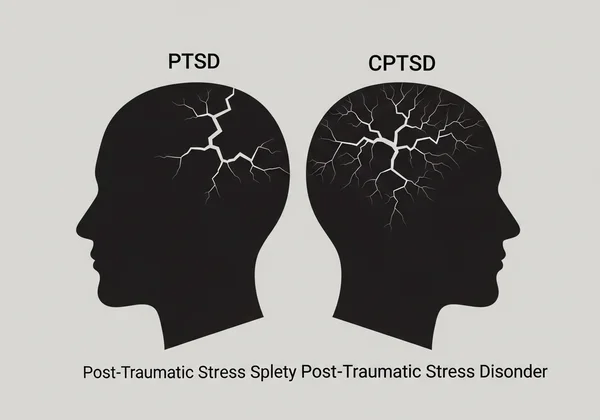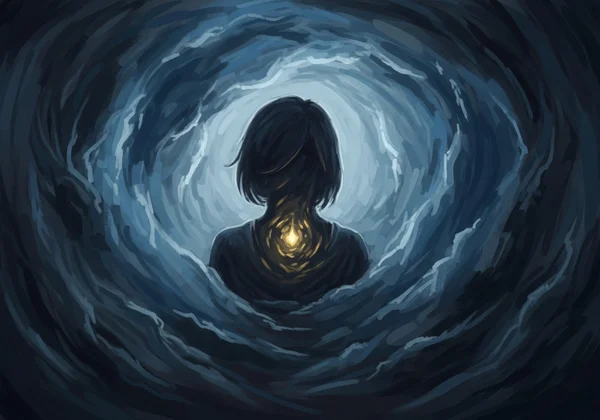What Is CPTSD? A Complete Guide for Survivors
Does the term "PTSD" feel incomplete? Like it doesn't capture the full depth of your struggles? If you've endured trauma that was prolonged or repeated, you might grapple with challenges that go beyond flashbacks, affecting the very core of who you are. Do you ever wonder if there's a name for the long-term impact of what you've endured?
You are not alone, and your feelings are valid. This guide is your starting point toward understanding Complex Post-Traumatic Stress Disorder (CPTSD). We will walk you through what it is, how it differs from PTSD, and what its core symptoms look like. And if you're seeking clarity, our free, science-based CPTSD test can be a confidential first step.

Defining Complex PTSD: More Than a Single Traumatic Event
What is CPTSD? At its heart, Complex PTSD is a psychological injury from prolonged, repeated trauma where escape was difficult or impossible. Unlike classic PTSD, which can arise from a single incident, CPTSD is rooted in chronic adversity.
The Core of CPTSD: The Impact of Repeated and Prolonged Trauma
The nature of the trauma is key. This includes ongoing situations such as:
- Childhood emotional, physical, or sexual abuse.
- Long-term domestic violence.
- Being a prisoner of war or victim of trafficking.
- Sustained, severe bullying.
This constant state of threat and helplessness creates the "complex" injury. It doesn't just change how you react to danger; it can alter your sense of self and your ability to connect with others. Recognizing these signs of complex PTSD is a powerful act of self-validation.
Official Recognition: Understanding the ICD-11 Definition of CPTSD
CPTSD is a formal diagnosis, officially included in the World Health Organization's ICD-11. This recognition validates the experiences of countless survivors and provides a clear framework for professionals. The ICD-11 provides the scientific foundation for our CPTSD screening tool.
CPTSD vs. PTSD: Understanding the Key Differences
Many people ask, "Isn't CPTSD just more severe PTSD?" The answer is no. How are they different? Think of it this way: CPTSD includes all the core symptoms of PTSD, but adds another layer of challenges.
| Feature | Classic PTSD | Complex PTSD (CPTSD) |
|---|---|---|
| Trauma Type | Often a single, terrifying event (e.g., car accident, assault). | Prolonged, repeated trauma with no easy escape (e.g., ongoing abuse). |
| Core Symptoms | Present: Re-experiencing, Avoidance, Sense of Threat. | Present: All three core PTSD symptoms are also part of CPTSD. |
| Additional Symptoms | Absent. | Present: A whole extra layer of symptoms called Disturbances in Self-Organization (DSO). |

The Added Layer: Disturbances in Self-Organization (DSO)
This is the defining feature of CPTSD. DSO refers to deep-seated difficulties that impact your identity and ability to function. It’s this layer that often makes survivors feel fundamentally "broken" or "flawed."
The 3 Core Symptom Clusters of CPTSD Explained
Let's break down the "Disturbances in Self-Organization" (DSO) as they appear in daily life.
1. Affective Dysregulation (Emotional Flashbacks & Intense Reactions)
This is more than just feeling sad or angry. It's about emotions that feel overwhelming and chaotic. You might experience:
- Emotional Flashbacks: A sudden flood of intense emotions from your past (like terror or shame) without a clear visual memory.
- Intense, Persistent Sadness: A deep sense of grief or despair that is hard to shake.
- Sudden and Intense Anger: Explosive anger that feels disproportionate to the current situation.
- Difficulty Feeling Positive Emotions: A persistent numbness or inability to feel joy.
If these emotional struggles feel familiar, a confidential CPTSD screening can offer valuable insight.
2. Negative Self-Concept (Deep Feelings of Worthlessness & Shame)
Prolonged trauma can shatter your self-worth, internalizing the message that you are somehow at fault. This often manifests as:
- Pervasive Guilt and Shame: Believing you are "bad," "worthless," or that the trauma was your fault.
- Feeling Fundamentally Different: A profound sense of alienation, as if you are permanently damaged.
- An Unrelenting Inner Critic: A harsh internal voice that constantly judges and belittles you.
This negative self-concept is one of the most painful aspects of the condition. It is not a character flaw; it is a symptom of trauma.
3. Disturbances in Relationships (Struggles with Closeness & Trust)
When safe people were the source of harm, it becomes incredibly hard to form healthy connections. This can look like:
- Avoiding Relationships: Isolating yourself to prevent being hurt again.
- Difficulty Maintaining Relationships: A cycle of intense but unstable connections.
- An Intense Fear of Abandonment: A deep-seated terror that anyone you get close to will leave.
- Struggling with Trust: A persistent feeling that you cannot trust anyone.

Who Is at Risk for Complex PTSD? Common Causes and Scenarios
Anyone can develop CPTSD, but certain cptsd causes are more common. The unifying theme is feeling trapped and powerless over a long period. These scenarios include:
- Childhood Abuse and Neglect
- Long-Term Domestic Violence
- Human Trafficking or Captivity
- Prolonged, Severe Bullying
The First Step to Healing: From Confusion to Clarity

The path to healing cptsd is not about "erasing" the past. It is about managing the symptoms, building a stable sense of self, and living a life no longer dictated by trauma.
Why Naming Your Experience Matters: The Power of Validation
Simply having a name for your experience—Complex PTSD—is powerful. It shifts the narrative from "What's wrong with me?" to "What happened to me?" This validation is the foundation upon which healing is built. It confirms your struggles are real, recognized, and a logical response to abnormal circumstances.
How Our Free CPTSD Test Can Be Your Confidential Starting Point
While a formal cptsd diagnosis must come from a qualified professional, gaining initial clarity in a private space is an empowering first step. Our free, confidential, and science-based CPTSD test is designed for this purpose. Based on the International Trauma Questionnaire (ITQ), it helps you organize your experiences and provides a clear summary to reflect on or share with a therapist.
Disclaimer: This website and its content are for informational purposes only and do not constitute medical advice. The test is a screening tool, not a diagnostic instrument. Please consult with a qualified mental health professional for any health concerns or before making any decisions related to your health or treatment.
Your Feelings Are Valid, and You Are Not Alone
Understanding Complex PTSD is a journey from confusion to clarity. It's a real condition, different from PTSD, rooted in prolonged trauma and defined by deep struggles with emotions, self-concept, and relationships.
Most importantly, healing is possible. It begins with knowing you are not broken and you are not alone. Your journey to understanding is important.
Frequently Asked Questions
How can I tell for sure if I have CPTSD?
A formal diagnosis must come from a qualified mental health professional. However, educational resources can be a valuable starting point. Our online CPTSD test can help you screen for symptoms privately, providing information to guide your next steps.
Is CPTSD just a more severe form of PTSD?
No, it is qualitatively different. It includes all PTSD symptoms plus the "Disturbances in Self-Organization" (DSO) cluster: severe difficulties with emotions, self-concept, and relationships. This extra layer makes it a distinct diagnosis.
Can Complex PTSD be cured?
While "cure" isn't the right word, significant recovery is absolutely possible. The goal is to reduce trauma's power over your life. The journey begins with awareness. A resource like our ITQ-based CPTSD test is designed to be a safe and informative starting point.